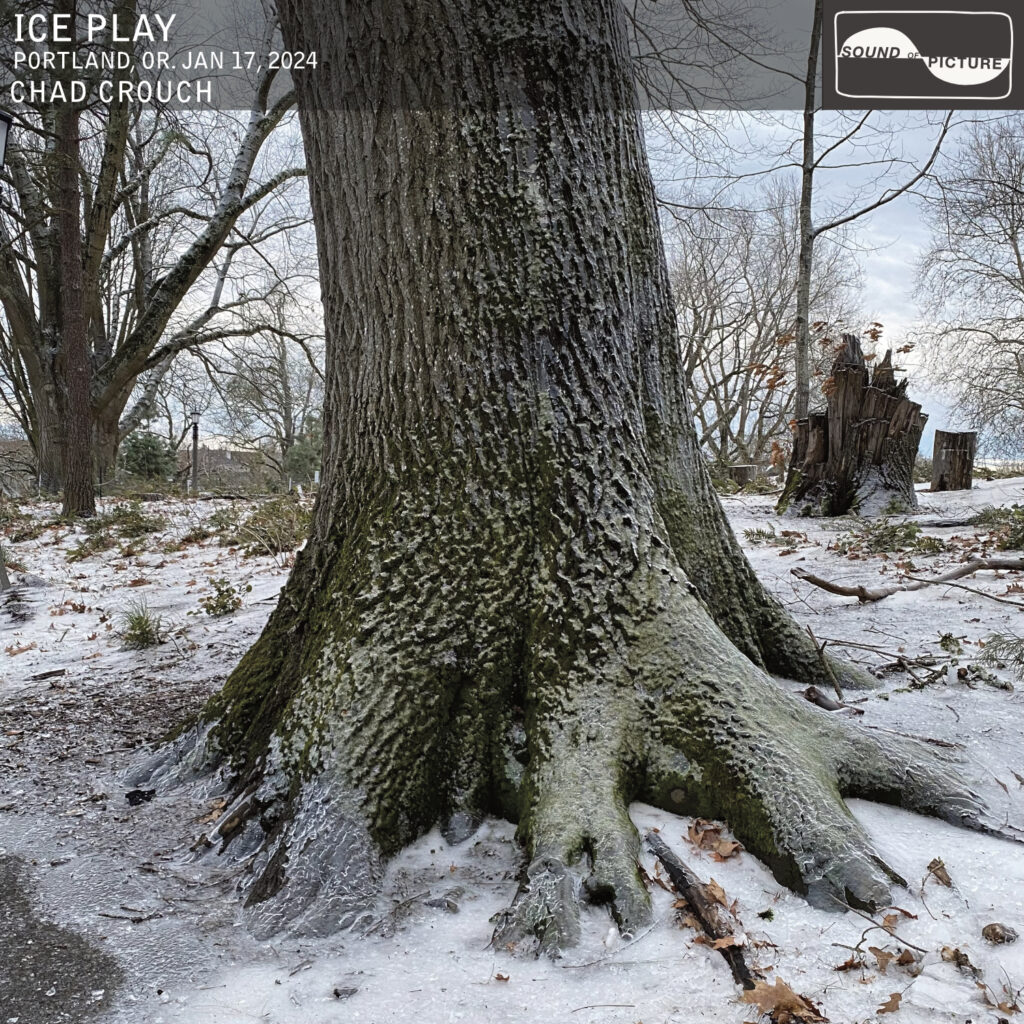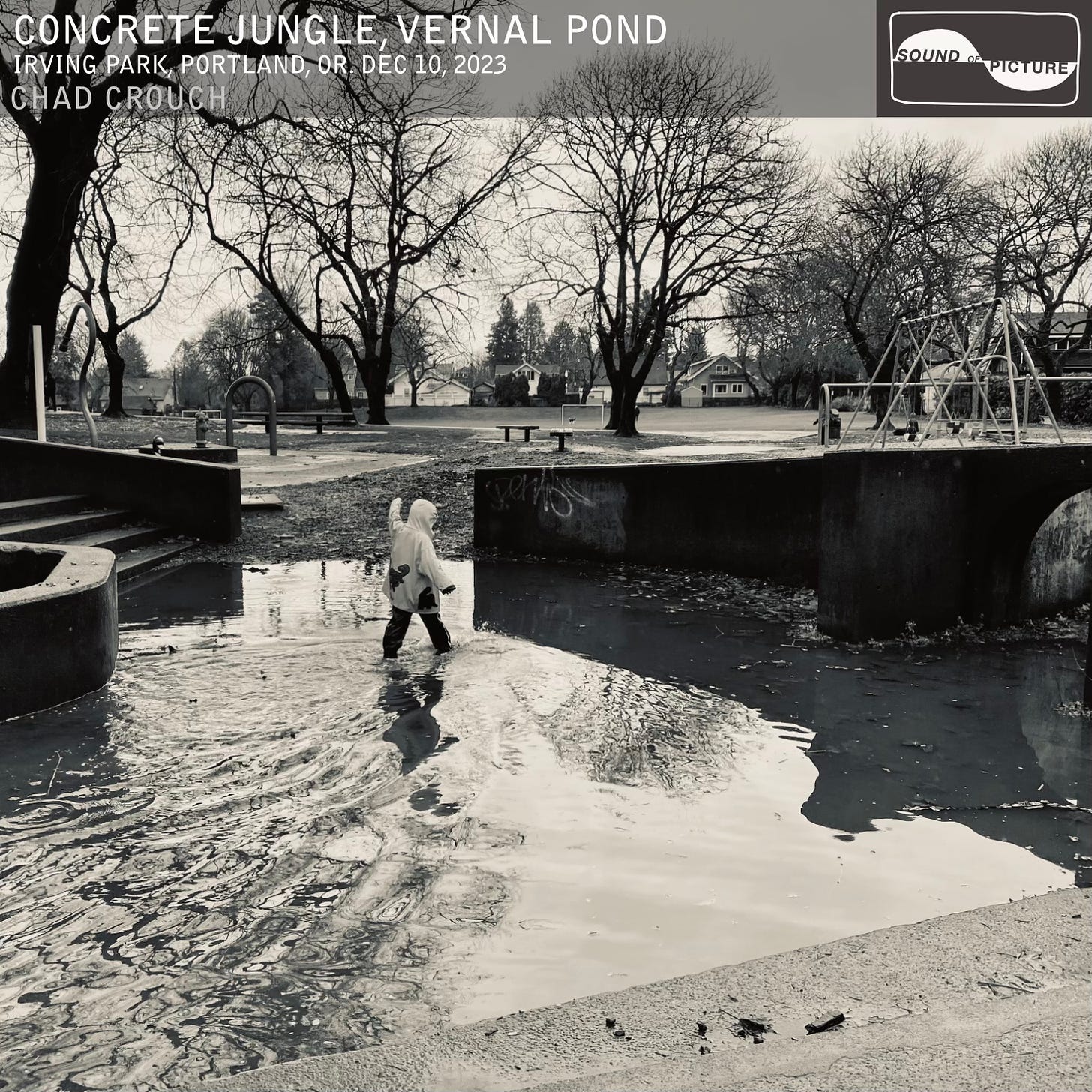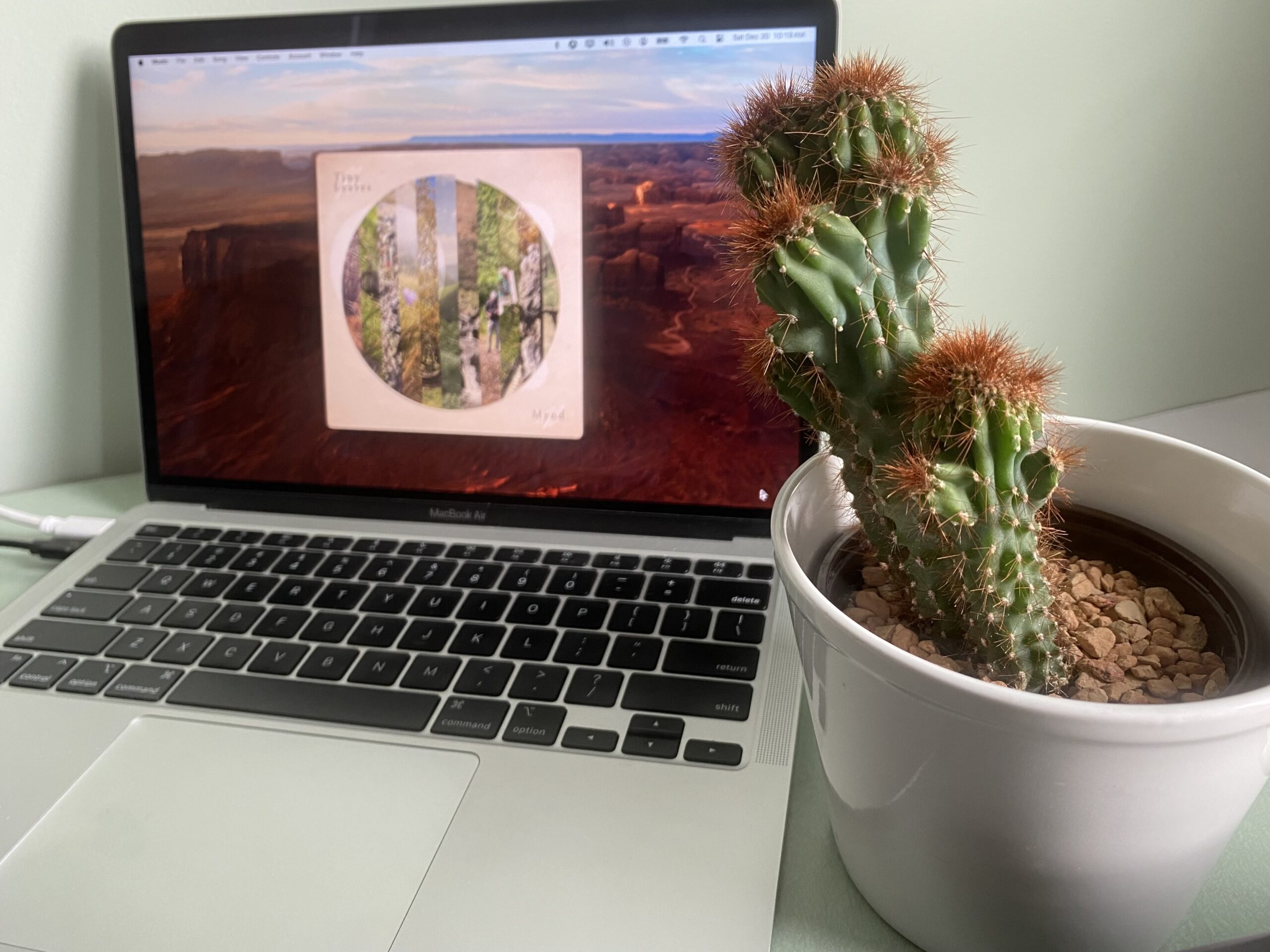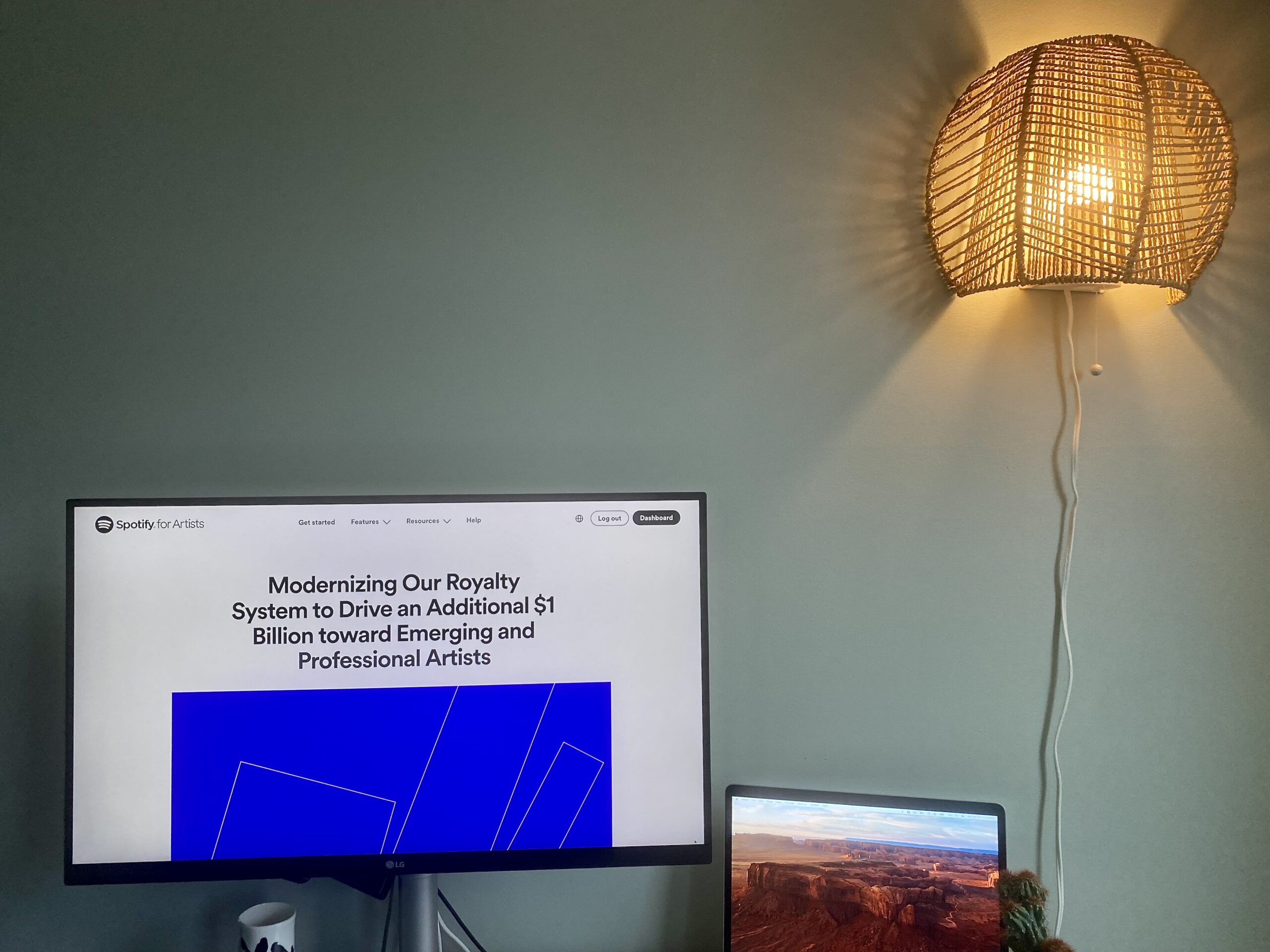Hey! I’m not updating the blog here. Find me here:
Ice Play

It started as a chore and quickly became a game. We have a magnolia tree in our yard. Five years old, maybe. Anyway, in the recent ice storm the broad leaves really piled up with ice, making the limbs droop in a scary way. My job was to go and pat the limbs with a broom before the melting ice re-froze, and in case more ice was on the way. The sound of the ice cracking and falling off was very musical and beautiful. I started recording.
Around the yard I went. The huckleberry hedge, the Pacific wax-myrtles, the leafless wisteria vines, the crusted-over lawn, and even the trampoline all made intriguing sounds when poked, patted and prodded at with an old broom. For the grand finale I shoveled and swept the ice off the trampoline. A one-take!
Next, I played some music alongside, as I do. My instrument palette here featured a Pianet electric piano, an unplugged Wurlitzer electric piano, A wobbly, fractalized Wurlitzer EP (electric piano, again) as well as clarinet, string and synth pads. It all came together with a really nice sense of curiosity and tenderness.
Of course there is such a thing as too much of a good thing, so the high frequency bursts of crackling ice needed to be reigned in. The soundscape plays out in real time just like it was recorded, but high pass and low pass filters play chutes and ladders all the way through, allowing the ice sounds to play a supportive textural and rhythmic role. Voila, Ice Play!
Now then, I could just put it up here for all the world but, I did that just a week ago with The Snowy Day, which is similar in some respects. So I guess now’s as good a time as any to ask you to consider becoming a premium subscriber. For less than 3 bucks a month, premium subscribers can expect a bunch of exclusive cool audio (like this) and storytelling every month.
So, I guess this is my soft start. As I write this, it has an audience of one. I hadn’t planned on soliciting for premium subscribers in the near future, but one made a pledge out of the blue and, well, broke the ice.
Ice Play is a 19 minute composition, the likes of which you’ve probably never heard.
Kelley Point Soundwalk
Creators are told you have just a couple seconds to hook your audience. I guess I’m more the catch-and-release type. The first seconds of my soundwalks often feature the sound of footsteps. It should come as no surprise; it is a soundwalk after all. It might be a set-up for a narrative arc, but hardly a hook. Kelley Point Soundwalk, out today, is the most quiet of this batch, and perhaps a love it or hate it proposition. The recording is hyper-focused on the lapping water of the Willamette and Columbia Rivers on a nearly windless day. It’s riparian ASMR—you know, that whole niche video genre of people whispering that seems to inspire tingles in some and guffaws in others? I recorded this soundwalk dangling a stereo microphone like a fishing lure from a four foot stick, just inches above the water. It captures all the slaps, slurks, sploinks, and splashes of the shoreline. It captures my footsteps too. It’s a lot to take in at first.

The instrumentation on Kelley Point Soundwalk is pretty spartan. Piano, harp, and celeste passages play out loosely, like the water. Occasional string arrangements add some gravitas. The melody just kind of builds in an iterative way. There’s some long, wobbly synth drones. It’s all very reflective. So let’s reflect…
The Snowy Day
Irving Park is where all the kids in the neighborhood come to sled down a small hill when it snows. I walked out in to the middle of the action and let my earbud microphones soak up the mirth. Have a listen to an excerpt:

My score is an arrangement for kalimba, celeste, glockenspiel, and synth(s). It is available exclusively on Bandcamp for free. It’s a one day soup to nuts recording, just like I used to do when I was first making music. It is also the kind of thing that I’m aiming to one day include on this Substack for premium subscribers (only). I’m not there yet. But that’s the idea for a way forward.
I thought about the classic children’s book The Snowy Day by Ezra Jack Keats when composing it. It tells the story of Peter and his adventures on a snowy day.
Concrete Jungle, Vernal Pond
Where shall we start this story? Let’s start in the present day.

On December 10th, 2023 I took receipt of a Sennheiser Ambeo Headset. This is a niche product on closeout (once $300, now $50), following Apple’s iPhone changeover to a USB-C port. The headset is of the old wired paradigm, earbud style, but larger and heavier than those that used to come standard with an iPhone, and so requiring a soft coat hanger curl to rest on the top of your ears. The main selling point for me was the promise of exceptional quality binaural sound recording, captured by two tiny microphones facing out from the earbuds.
So I padded over to Irving Park to test it out and no sooner did I arrive at a novel scene when the action was just beginning. The scene itself was familiar: a roughly 75’ wide amoeba shaped concrete derelict terrace and wall in mysterious disuse for several decades. (These days it is mostly enjoyed as parkour grounds.) But on this day, owing to an atmospheric river event, the basin was completely flooded and for the first time in recent history it was briefly brought to life as what I always assumed it originally was: a wading pool.
For the audio experience and exciting conclusion, please visit my Substack newsletter.
10 Underexposed 2023 Releases
A list of underexposed releases from the past year that caught my ear.
Don’t miss out on any future recommendations. Subscribe to my newsletter via Substack
Tiny Leaves may be the closest modern kindred spirit I’m aware of, exploring the fertile space between field recording and instrumental music inspired by–and designed to be in conversation with–the natural soundscape. Mynd goes deeper, using biological data in the composition process, as well as in-situ instrument recording, and harnessing the wind for a glockenspiel performance, for example. Comparing it to my own repertoire, it’s like half Soundwalk (there is a narrative thread here, and footsteps are part of the composition), and half Field Report (each song feels like a window, with distinct moments in time and space captured by the field recordings), presenting a constellation of impressions from The Long Mynd in the Shropshire countryside.
Siren & The Sea – Gravity Wave
A departure for pop artist Christina Cano, Gravity Wave is a compelling ambient/new age debut, and cornerstone release for the fledgling label Bathysphere Records. Pulsing synth arpeggios give the compositions mesmerizing movement, while the sound palette does not shy away from the synthetic patches of the late 70s-80s. If the name Kitaro means anything to you, you’ll find in Gravity Wave a compelling tribute (and update) to that era. Another brave experiment I admired about this release was only half of the tracks were released to streaming platforms. For the full EP, you needed to purchase a cassette or listen on Bandcamp. A prescient adaptation for the new Spotify era?
Because theatrical scores tend to require music that is all over the map stylistically and dynamically, I don’t tend to find myself settling into them for repeat listens. L’Immensita is not that kind of score. It works really well as an album. I find its breathy woodwind and hushed flautando string arrangements both immaculate and gorgeous. This is an album that can work in the background or foreground; its details are subtle, but there for the discovery.
Graves – Gary Owens: I Have Some Thoughts
Songwriter Greg Olin hit paydirt when he countrified his indie ballads and adopted a distinctly personal storytelling angle for his lyrics. Who is Gary Owens, exactly? It’s a bit of a mystery, but it’s interesting to note the alter-ego inspired a work at once so intimately personal and universal.
Spiddal is a welcome release from PNW-Australia singer-songwriter Shelley Short, arriving six years after her last full length. This is an apt sequel to 2017’s Pacific City, recorded again with the support of multi-instrumentalist Peter Broderick whose warm enthusiasm, natural way with children (he was the childcare provider for the sessions), and understated touch as a producer play no small part of capturing these songs for the record. Of Course it’s Shelley’s timeless voice, her vivid lyrics, and her melodic sense that remains magnetic.
Igor Khabarov is a Russian pianist who came late in life to study the instrument. 4 comes on the heels of the impressive Blank: Etudes for One Hand. Listening to “Forget” or “Snow Song” from that Blank will have you wondering aloud, How on earth is one hand playing all those notes? If Blank is the sound of one hand playing, is 4 the sound of four? Yes but not entirely. The compositions don’t sound busy, or over-stuffed. There are crescendo passages that definitely sound like the work of four hands, and the EP-closing track Four is a rousing climax of overdubbed performances, but when you know what this pianist can accomplish with just one hand, you have to think twice.
Michael Scott Dawson – Find Yourself Lost
I think of Michael Scott Dawson as another bird of a feather, given his recent albums incorporate field recordings liberally. Each one is a masterpiece of tone. Find Yourself Lost employs fewer natural soundscapes in favor of a human voices and sound fragments, the whir of a projector, and other subtly mechanical sounds. The distinct warp of pedal steel and twangy riffs that sparsely decorate the glacial melodies give this album a more western feel. The cover art is a pitch-perfect representation of the sound: pastoral, but harrowing.
Brass Clouds is the work of shapeshifter Dustin Dybvig. The plasticity and scope of these compositions is impressive. Escape Vessels drifts from ambient cloudscapes to fractalized, kalleidoscopic rhythms. Electric piano and live drums imbue the melange with a touch of jazz cool. It sounds like nothing else that I know of.
Schaus reminds me a little bit of YACHT’s Jona Bechtolt, for this decade. Listening to Lovers Loop I hear someone who is really, really connecting with their tools in an evolved way. The production ideas just come bursting out of the speakers, fast and furious. If I had to guess, there’s a capable drummer behind the programming. The vocal delivery is crooner meets post-pop. This is a polished album that you’d expect to discover on POLLEN or other bleeding-edge playlists.
Saroon is the moniker of singer-songwriter-composer Ayal Alves. Gilgul is highly conceptual, evolving from a work that became its centerpiece; “Traffic Operators on the Transmigration Highway”. I particularly like the voiceover in the final act of that piece, lending an almost procedural tone to the invocation: “Alright you may experience a little inner peace here.” That might lead you to think it’s an artsy, or self-indulgent work. It’s not. It’s approachable and engaging.
2024: Ch-ch-ch-ch-changes (Turn and face the strange)
In the waning of 2023, the news that Spotify was ‘modernizing’ its royalty system came as cold comfort when it dawned on me how squarely I seemed to be targeted by unfavorable changes. It wasn’t personal, but I took it that way. As someone who hyperactively releases audio content , I was mindful of the risks: my credibility as an artist could suffer, I could overwhelm even super-fans with content, I could dilute the value of my repertoire, and I could alienate people with my too-frequent release announcements. One thing that kept the wind in my sails was that my music seemed to be catching on; my audience on Spotify grew in 2023. A lot.
I’m genuinely grateful to Spotify, its users, and the small handful of outspoken supporters for the opportunity to find an audience on the platform. Other times I feel cynical, as if Spotify is emblematic of so many problems that exist for working musicians today.
Projecting the implications of Spotify’s changes on my own revenue stream was sobering. Assuming my soundscape-centric music isn’t ensnared in the noise crackdown–given that nature sounds are henceforth bucketed with, white noise, the sound of a fans, etc. and devalued by 80%–to what extent did the 1000 stream threshold for songs to be eligible for royalties figure into my picture? Think of a high number. Then go higher…
Finish this post and consider subscribing to my newsletter at Substack
Hello.
My website, which had seemingly been frozen in amber for about a decade, recently broke badly enough that I just deleted it, rather than making heroic attempts to fix it. It’s almost a new year. Why not just start from scratch?
So here I am starting from scratch. Admittedly I’m a little uneasy about it, as I write this without much space between the digital implosion and now. I have to think it’s for the best though. Why wouldn’t it be? Look at all this space!
More soon…

